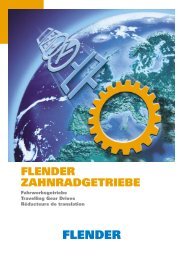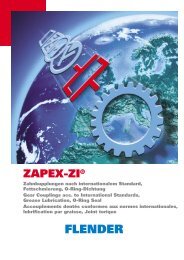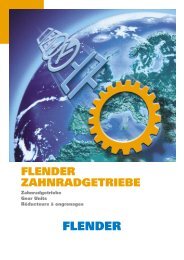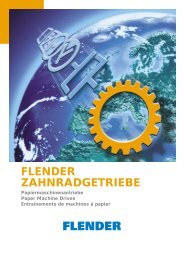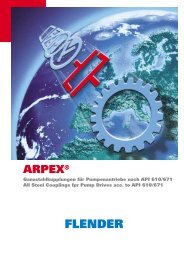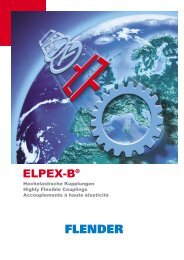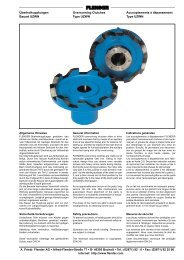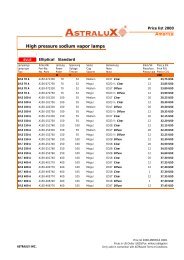fluid couplings - Laumayer
fluid couplings - Laumayer
fluid couplings - Laumayer
You also want an ePaper? Increase the reach of your titles
YUMPU automatically turns print PDFs into web optimized ePapers that Google loves.
RECOMMENDED OIL AND QUANTITY<br />
SAFETY DEVICES<br />
9. OIL FILL<br />
Trans<strong>fluid</strong> <strong>fluid</strong> <strong>couplings</strong> are not generally filled with oil, so<br />
it is necessary to follow the procedure reported here below to<br />
achieve the standard fill X for K series, fill 2 for CK series and fill<br />
3 for CCK series:<br />
1 - position the <strong>fluid</strong> coupling axis horizontally, turn it until the X<br />
mark (respectively 2 or 3 according to the <strong>fluid</strong> coupling type)<br />
cast into the housing gets at the top vertical (maximum oil fill),<br />
so that the oil plug is inclined as shown in Fig. 5.<br />
2 - fill with oil until it overflows out of the filler hole. While filling,<br />
gently rock the coupling on its axis to make sure all air excess<br />
is vented out of the circuit. The quantities to be introduced are<br />
those reported in Tab. E.<br />
3 - screw the cap and make sure no leakages occur; otherwise<br />
use thread sealant on filler plug threads.<br />
4 - the fillings marked X-1-2-3-4 may be chosen by the operators<br />
to meet the best performance in terms of start-up and steady<br />
running condition.<br />
5 - for normal operating conditions, use only ISO HM 32 (or<br />
equivalent SAE 10W).<br />
At low ambient temperatures (near 0°C), it is recommended to<br />
use ISO FD 10 (or equivalent SAE 5W) oil.<br />
For temperatures below –10°C, ask Trans<strong>fluid</strong>.<br />
6 - for vertical mounted applications, the <strong>couplings</strong> recommended<br />
oil fills are reported in Tab. E.<br />
Size<br />
6<br />
7<br />
8<br />
9<br />
11<br />
12<br />
13<br />
15<br />
17<br />
19<br />
21<br />
24<br />
27<br />
29<br />
34<br />
D34<br />
SERIES K<br />
RECOMMENDED OIL: ISO 32 HM<br />
Agip OSO 32<br />
Aral VITAM GF 32<br />
Bp ENERGOL HLP 32<br />
Castrol HYSPIN AWS 32<br />
Chevron RPM EP HYDRAULIC 32<br />
Esso NUTO H32<br />
Mobil DTE 24<br />
Shell TELLUS 32<br />
Texaco RANDO HD 32<br />
Total AZOLLA ZS 32<br />
Fillings<br />
OIL QUANTITY lt<br />
FILL X FILL 2 FILL 3<br />
0,50<br />
—<br />
—<br />
0,92<br />
—<br />
—<br />
1,50<br />
—<br />
—<br />
1,95<br />
—<br />
—<br />
2,75<br />
3,35<br />
—<br />
4,1<br />
4,8<br />
—<br />
5,2<br />
5,6<br />
—<br />
7,65<br />
8,6<br />
9,3<br />
11,7<br />
13,6<br />
16,4<br />
14,2<br />
16,5<br />
18,8<br />
19<br />
23<br />
27,3<br />
28,4<br />
31,2<br />
35,5<br />
42<br />
50<br />
59,5<br />
55<br />
63<br />
70,6<br />
82,5<br />
92,5<br />
96,7<br />
162<br />
—<br />
—<br />
SERIES CK<br />
SERIES CCK<br />
24<br />
10. SAFETY DEVICES<br />
FUSIBLE PLUG<br />
In case of overloads, or when slip reaches very high values, oil<br />
temperature excessively increases, damaging oil seals and<br />
letting oil out.<br />
To avoid damage, for severe applications it is advisable to fit a<br />
convenient fusible plug. Fluid <strong>couplings</strong> are supplied with a<br />
fusible plug at 145°C (120°C, 175°C or 198°C upon request).<br />
SWITCHING PIN<br />
Oil leakage out of the fusible plug may be avoided with the<br />
installation of a switching pin device. When the temperature<br />
reaches the melting point of the fusible ring element, this<br />
releases a pin that intercepts a relay cam, giving an alarm or<br />
stopping the main motor supply.<br />
As for the fusible plug, 3 different fusible rings are available (see<br />
page 25).<br />
ELECTRONIC OVERLOAD CONTROLLER<br />
It consists of a proximity sensor measuring the speed variation<br />
between input and output of the <strong>fluid</strong> coupling, giving an alarm<br />
signal or stopping the motor in case the set threshold is<br />
overcome.<br />
With such a device, as well as with the infrared temperature<br />
controller, no further maintenance or repair intervention is<br />
necessary after the overload situation, because the machinery<br />
can regularly go on, once the cause of the inconvenience has<br />
been removed (see page 26).<br />
INFRARED TEMPERATURE CONTROLLER<br />
To measure the operating temperature, a device fitted with an<br />
infrared sensor is available. After conveniently positioning it by<br />
the <strong>fluid</strong> coupling, it allows a very precise non-contact<br />
temperature measurement.<br />
Temperature values are reported on a display that also allows the<br />
setting of 2 alarm thresholds to be used by the customer (see<br />
page 27).<br />
Tab. E<br />
Fig. 5<br />
4 3 22<br />
1 X<br />
X X 11<br />
22<br />
33<br />
4<br />
13



